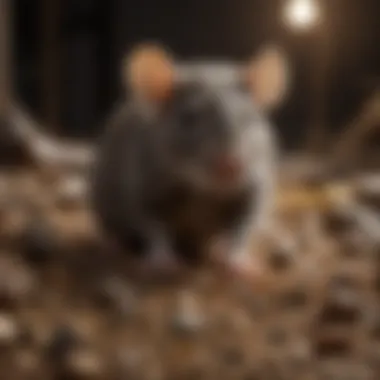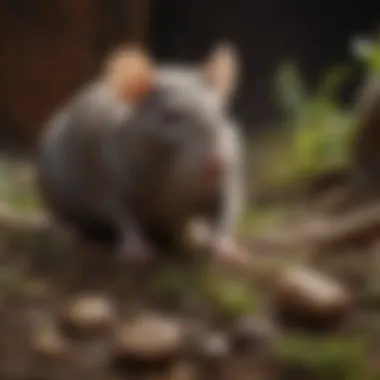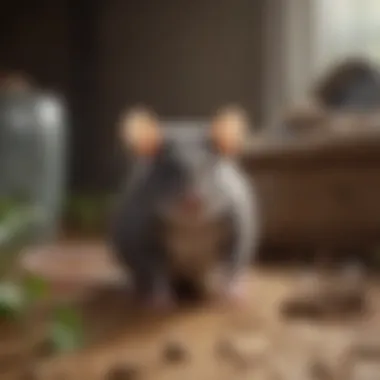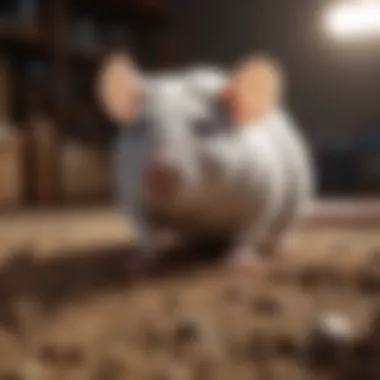The Ultimate Guide to Choosing Rat Litter


Intro
Selecting the right litter for your pet rat is a crucial decision. After all, the litter impacts not just the cleanliness of their living space but also their health and comfort. In this article, we aim to delve deeply into the various litter options available, examining each type’s properties, benefits, and downsides. By ensuring that pet owners are well-informed, we can help enhance the well-being of these small furry companions.
Understanding Your Pet
Pet Behavior Basics
Rats are social creatures that enjoy interacting with their environment. They exhibit unique behaviors that can be influenced by their living conditions, including the type of litter used. Understanding their behaviors, such as burrowing, nest building, and exploratory tendencies, helps in choosing litter that caters to these instincts.
Common Breed Characteristics
Different rat breeds display various traits. For instance, Dumbo rats often have a calm demeanor, while Standard rats can be more energetic. It is essential to consider these characteristics when selecting litter, as it would affect how they react to their environment. Some may prefer softer substrates for comfort.
Species-Specific Needs
Pet rats have distinct needs that differ from other rodents. They require ample space to move around and a secure litter area. Choosing the right litter enhances their habitat, considering factors like dust levels and absorbency. Always prioritize options that ensure their safety and comfort.
Litter Types Overview
Several types of litter are available in the market. Common options include paper-based, wood shavings, and corn-based litters. Each of these varieties has particular properties. For example, paper-based litter offers excellent absorbency and is dust-free, making it safer for your pet's respiratory system.
Benefits and Downsides of Each Litter Type
- Paper-based: Excellent absorbency, no dust. However, it may not control odors as effectively as others.
- Wood Shavings (such as aspen or pine): Usually good for odor control but can create dust, which is not ideal for respiratory health.
- Corn-based: Environmentally friendly and offers great absorbency, but some people may find it less effective against strong odors.
Selecting the right litter can significantly impact a rat's behavior and overall well-being.
Pet Care and Maintenance
Feeding Guidelines
Proper nutrition is vital for your pet rat's health. They require a balanced diet consisting of high-quality pellets supplemented with fresh fruits and vegetables. Ensure that you monitor their food intake and adjust it according to their activity levels.
Grooming Essentials
Despite being low-maintenance pets, rats still benefit from regular grooming. They should be brushed occasionally, especially if they have longer fur. This helps to prevent matting and keeps their coat healthy.
Hygiene Practices
Maintaining a clean cage is essential. Regularly change the litter and clean the cage to prevent any buildup of waste or odors. This will foster a healthier living environment for your pet rat.
Training and Development
Basic Commands and Skills
Training your rat can enhance your bond. Start with simple commands like "come" or "stay" using treats as rewards.
Behavioral Training Techniques
Positive reinforcement is an effective method. It encourages good behaviors while discouraging bad ones.
Addressing Common Behavior Issues


Sometimes rats may develop habits like biting or excessive chewing. Identifying the triggers for these behaviors is crucial to finding suitable solutions.
Health and Wellness
Routine Vet Check-ups
Regular veterinary visits are important. These check-ups can help identify potential health issues early.
Vaccination Needs
Rats require specific vaccinations. Consult your vet to ensure your pets are protected against common diseases.
Recognizing Signs of Illness
Be vigilant for signs of illness such as lethargy, unusual eating habits, or changes in behavior. Prompt action can prevent minor issues from becoming serious.
Enrichment and Activities
Indoor vs. Outdoor Activities
Providing enrichment through play is essential. Indoor activities can include climbing structures and tunnels, while outdoor playtime should be supervised for safety.
Interactive Toys and Games
Invest in interactive toys that engage your pets physically and mentally. These keep them stimulated, preventing boredom and promoting a healthier lifestyle.
Socialization Opportunities
Socialization is key for pet rats. Spend time daily with them to encourage positive interactions and prevent anxiety.
Understanding Rat Litter
Understanding rat litter is a fundamental part of providing a comfortable and safe living environment for pet rats. This section will delve into the several aspects that are crucial when choosing litter. Selecting the right litter goes beyond mere functionality. It shapes your pet’s well-being and affects their health, behavior, and even the overall cleanliness of your home. Thus, making informed choices about litter types, based on their properties, can benefit both the pet and the owner.
What is Rat Litter?
Rat litter serves as bedding material in a rat's cage, offering essential comfort and hygiene. Traditionally, litter can be made from various materials like paper, wood, and even corn. The primary purpose of rat litter is to absorb urine and control odor. It provides a cozy place for rats to nest, sleep, and engage in their natural behaviors. Litter can create a barrier against waste products, assisting in maintaining a clean habitat.
The composition of the litter often influences its absorbency and odor control capabilities. Because rats are playful and naturally curious, they often dig and burrow through the litter. It is crucial that the litter be safe and non-toxic, considering that rats may ingest small amounts while grooming themselves.
Importance of Choosing the Right Litter
Choosing the right litter is vital for several reasons. First, the health and safety of your pet depend greatly on this choice. Some litters, especially those made from clay, can contain harmful chemicals. If a rat absorbs these through its skin or ingests them, it can lead to significant health concerns. Second, the lining of the cage with appropriate litter can prevent issues related to hygiene. Defaulting on this can have adverse effects, such as increased odor and potential infections.
Maintaining an ideal environment with proper litter can reduce stress levels in rats. It gives them a sense of security and comfort, crucial for their overall well-being. Additionally, another crucial point is the ease of cleaning that litter can provide to the owner. Different materials have varying maintenance needs that can affect how often you will have to clean the cage. Choosing litter that simplifies clean-up tasks can ultimately save time and make the experience more pleasant for both the pet and the owner.
"Selecting appropriate litter contributes to the overall happiness and health of your rats, making it a significant part of their care routine."
To summarize, comprehending what rat litter is and appreciating its importance is essential. Making the right choice affects not just your pet's day-to-day life but also long-term health and happiness. Thus, it is worth investing time and consideration into this aspect of rat ownership.
Types of Rat Litter
Selecting the correct type of litter is crucial for the well-being of your pet rat. Each litter type brings its own features, advantages, and drawbacks that are important for consideration. Understanding the differences among paper-based, wood-based, corn and wheat, clay, and coconut coir litters helps rat owners make informed decisions. The chosen litter not only affects the cleanliness of the habitat but also impacts the comfort and health of your pet. This section provides insight into various types of rat litter, highlighting their characteristics, benefits, and other relevant considerations.


Paper-Based Litters
Paper-based litters, made primarily from recycled paper, are popular among rat owners. This type offers good absorbency and is relatively dust-free, making it suitable for sensitive respiratory systems. Additionally, it is lightweight and easy to handle. One key advantage is that paper-based litter is often biodegradable, aligning with eco-friendly practices. However, it may not control odors as effectively as other materials and could require more frequent changes to maintain cleanliness. It is essential to consider the specific brand, as formulations and absorbency can vary.
Wood-Based Litters
Wood-based litters come from compressed wood pellets or shavings. These litters have excellent absorbency, allowing for effective moisture control. Many wood-based litters also provide natural odor neutralization due to their innate properties. This can lessen the amount of cleaning needed, which is an advantage for busy pet owners. However, some wood litters can create dust that might irritate a rat's airways. Additionally, certain types may contain harmful chemicals. Therefore, it is essential to choose natural, untreated options to ensure the safety of your pets.
Corn and Wheat Litters
Corn and wheat litters are made from dried agricultural by-products. They are designed to be biodegradable and often boast good absorbent qualities. One benefit is that they typically provide better odor control than paper-based litters. Additionally, corn and wheat litters are usually clumping, making waste removal easier for the owner. However, some rats may have allergies to certain grains, so monitoring your pet’s response is vital. Consideration should also be given to availability, as not all stores may stock these types of litter.
Clay Litters
Clay litters, especially those made from sodium bentonite clay, are known for high absorbency and effective odor control. They also tend to clump, which simplifies cleaning. However, clay litter is heavier and can produce dust, raising concerns for respiratory health. While it is widely available, it is essential to be cautious of the potential risks. Look for natural clay options that are free from aromatic fragrances and other added chemicals to ensure safety for your rat.
Coconut Coir Litters
Coconut coir litter, derived from the husk of coconuts, is gaining popularity due to its sustainable nature. It is known for its excellent moisture retention and is biodegradable. This type of litter is also typically free from dust. Another advantage is its natural ability to control odors effectively. However, it might not be as readily available in every pet store, and some rats may require a transition period before fully accepting it. Ensure that the coir product is natural and free from chemicals for the healthiest options.
Each type of rat litter comes with its unique properties and impacts; understanding them is key to making a good choice.
Comparative Analysis of Litter Types
In selecting the appropriate litter for pet rats, one must consider various litter types on the market. A comparative analysis of these types is crucial in understanding their distinct features, advantages, and potential drawbacks. By evaluating the properties of each litter type, pet owners can make an informed decision that suits the needs of their furry companions. This analysis encompasses absorbency, odor control, safety considerations, and environmental impact, all of which contribute significantly to the overall living conditions of pet rats.
Absorbency
Absorbency refers to how much liquid a litter can soak up, which is essential for maintaining a hygienic environment for rats. Litter that excels in absorbency helps control moisture levels and keeps waste from accumulating. Effective absorbent litter can help reduce the need for frequent changes, which can be beneficial for the owner.
Different types of litter exhibit varying levels of absorbency. For instance, clay litters tend to have high absorbency due to their fine particles that trap moisture efficiently. On the other hand, paper-based litters may absorb less liquid but provide adequate moisture control if managed properly. The right choice can depend on the specific needs of the rat and the owner's preferences for maintenance.
Odor Control
Odor control is another vital aspect to consider when selecting rat litter. Rats can produce strong odors, especially in confined spaces. Therefore, selecting litter with good odor-neutralizing properties is essential for maintaining a pleasant environment.
Some litters, like those made from corn or wheat, naturally combat odors due to their composition, making them popular among rat owners. Additionally, clay litters often contain baking soda or other additives aimed at suppressing smells. However, it is important to monitor how effectively the litter manages odors, as this can vary significantly between products. A litter type that fails to control odor effectively may lead to an unpleasant living area for both pet and owner.
Safety Considerations
When it comes to the welfare of pet rats, safety is paramount. Not all litters are created equal, and certain materials can pose health risks to pets. Some clay litters contain additives or fragrances that can irritate a rat's sensitive respiratory system. A more natural option, such as paper or coconut coir, tends to be safer for small animals. It is crucial to choose a litter that is free from harmful chemicals, dust, and allergens, thereby ensuring the safety and well-being of the pets.
In addition, it’s advisable for owners to pay attention to the litter's grain size and dust levels. Litter with fine particles can create respiratory issues, so maintaining proper ventilation in the rats’ habitat is also a must.
Environmental Impact
The environmental aspect of litter selection is gaining attention among conscientious pet owners. Many litters come from renewable resources while others may have a significant ecological footprint. Paper-based litters, for example, are often recycled and can be more sustainable compared to traditional clay litters that involve strip mining practices.
When choosing a litter, considering its biodegradability is important. Some litters, like corn and wheat varieties, offer composting options and break down without harming the environment. This provides an opportunity for pet owners to make a subtle yet positive impact on the planet through their choices.
In summary, the comparative analysis of litter types allows pet owners to weigh the advantages and disadvantages critically. This understanding is essential for promoting the health, comfort, and safety of their rat companions while also considering the broader effects on the environment.
Factors Influencing Litter Selection


Selecting the best litter for your pet rat is more than just a matter of personal preference. There are multiple factors that come into play, making it essential to consider both your rat’s needs and your own preferences. Understanding these influences can help create a healthier living environment for your furry companions. This section explores the key elements that shape litter selection, focusing on behaviors of rats and the inclinations of their owners.
Rat Behavioral Traits
Rats exhibit unique behavioral traits that can significantly inform the choice of litter. Understanding these traits is key to ensuring comfort and proper hygiene.
- Digging and Burrowing: Rats have an instinctive behavior to dig and burrow. This means that they prefer litters that allow for some manipulation. A softer, more malleable litter, like paper-based options or coconut coir, may be more inviting for these activities.
- Nesting: Rats create nests for sleeping and resting. Litter that can be used for nesting should be absorbent and comfortable. Because of this, litters that can be compacted and molded are preferable.
- Odor Sensitivity: Rats have a keen sense of smell. They may become stressed or uncomfortable if their living environment is too odorous. Therefore, choosing a litter with good odor control properties is significant. Clay litters or those made from natural materials like corn can mitigate strong smells effectively.
- Health Considerations: Certain litters could pose health risks if ingested. For instance, litters containing harmful chemicals or dust can lead to respiratory issues. Understanding the health implications is crucial and should influence the selection process.
In essence, the natural behaviors of rats suggest that the material used as litter must cater to their instincts while promoting a clean and safe environment.
Owner Preferences
While rodent behavior is important, owner preferences cannot be overlooked. Owners have their own unique priorities, which can influence litter choices in various ways.
- Ease of Cleaning: Many owners seek litters that simplify maintenance. The ability to scoop waste quickly and change litter without too much hassle is a significant concern. Some owners may prefer clumping litters for ease of removal.
- Cost: Budget-friendly options often take precedence. Recognizing the balance between quality and price can help in making informed decisions. Some litters may be more economical in the long run despite a higher initial cost.
- Environmental Considerations: Increasingly, pet owners are concerned about eco-friendliness. Selecting biodegradable litters made from renewable resources can align with such values. Litters like those from recycled paper or corn are favorable in this regard.
- Allergies and Sensitivities: Owners need to be cautious about choosing litter types that may trigger allergies, either for themselves or their pets. Dust-free options are essential for those prone to allergies.
- Aesthetic Appeal: Appearance might seem trivial, but the visual aspect of litter can influence selection. Some owners prefer litter that blends well with their home decor or cage setup.
Practical Tips for Using Rat Litter
Using the right litter is essential for the health and well-being of your pet rat. Each type of litter has its own specific properties and benefits. Implementing effective practices helps both you and your pet. Proper litter usage promotes hygiene, controls odor, and maintains a comfortable environment.
How to Introduce Litter to Your Rat
Introducing litter to your rat should be done carefully. Start by placing a small amount of the selected litter in their habitat. It's important to let your rat explore it at their own pace. Initially, they may show curiosity about the texture and scent.
Key steps for introducing litter:
- Choose a litter type suitable for your rat's needs.
- Gradually mix it with any old bedding to create familiarity.
- Observe their reactions to ensure they feel comfortable.
Rats are sensitive creatures. If they seem hesitant, give them time and space. Patience is key to helping them adapt. Over time, they will recognize the litter area as their bathroom, leading to better litter habits.
Maintaining a Clean Litter Box
The cleanliness of your rat’s litter box cannot be overstated. A clean environment minimizes health risks. Regular maintenance also encourages good litter habits. Here’s a simple routine to follow:
- Daily checks: Look for soiled litter and remove it promptly.
- Weekly cleaning: Empty and wash the entire litter box with a pet-safe cleaner.
- Replenish litter: After cleaning, add fresh litter to maintain comfort and absorbency.
Benefits of a clean litter box:
- Reduces odors effectively.
- Helps prevent the spread of bacteria.
- Ensures a healthier living space for your rat.
A regular cleaning routine is essential for the health of both the pet and the owner.
Signs of Litter Issues
Maintaining attention to your litter box's condition is crucial. If you notice changes in your rat’s behavior, it could indicate litter issues. Here are common signs:
- Avoidance of the litter area: If your rat avoids their litter box, it could signal discomfort.
- Increased odor: Strong odors may indicate improper absorbency or the need for cleaning.
- Health concerns: Changes in urination or defecation patterns can be linked to litter type or cleanliness.
Address these issues promptly. An unsuitable litter selection or a dirty litter box can lead to stress for your rat. Regular observation and a good routine are necessary to ensure their well-being.
Culmination
In selecting the best rat litter, understanding the implications of your choices is crucial. This article highlights the significance of making informed decisions regarding litter types, as these can directly impact your pet's comfort and health. The right litter not only enhances hygiene but also contributes to the overall well-being of your rat, which should always be a priority for pet owners.
Through various types of litter, such as paper-based, wood-based, corn, wheat, clay, and coconut coir, one finds that each option has unique attributes, advantages, and drawbacks. Assessing which litter type aligns with your rat’s behavior and your own preferences is essential. For instance, some litters might excel in odor control but come short in absorbency or safety.
Monitoring your rat's response to different litter types is vital. You may notice behaviors that indicate a preference or discomfort. This vigilance helps ensure that your furry companion feels at ease in its environment.
Moreover, proper maintenance of the litter box is an ongoing responsibility. Regular cleaning routines keep the living area healthy and minimize unpleasant odors. This not only benefits your rats but also promotes a positive experience for anyone who interacts with them.
Choosing the right litter has benefits extending beyond basic hygiene; it enhances the quality of life for your rat and fosters a positive relationship between pet and owner.







